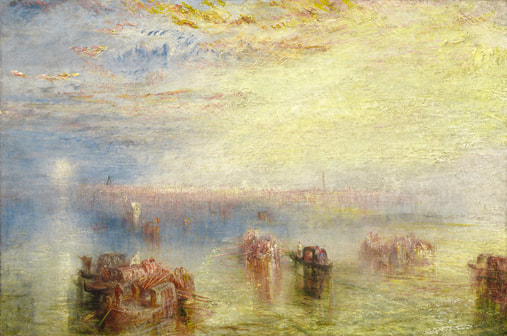It is, at all events, utterly impossible to inspect these drawings without being satisfied of his wonderful genius. He is largely indebted to Mr. Windus for determining a matter about which — strangely — there is some doubt, for many just critics and sensible persons turn, dissatisfied, from what they consider the exaggerated deformities of his later works.
Turner's later paintings
|
BG Windus views on the later paintings of JMW Turner according to his daughter, Mary, in In Memoriam:
When Turner’s later pictures were scoffed at by the many for their supposed eccentricity, he revelled in their wonderful beauty and boldly declared them to be far in advance of the earlier works of the painter, which the public were just beginning to appreciate. Ruskin, one of Turner’s rare champions in later his career, on Approach to Venice exhibited at the RA in 1844:
"...The public appear to understand Turner a little better this year - the railroad pleases them [this refernce is to Rain, Steam, and Speed - the Great Western Railway. The two yellow Venices I don't like but the third - the approach - with the blue mist & moon - I am deeply in love with - I don't know if we shall be able to resist it - unless it is already sold - the sweetest thing he ever did in oil - I think. To Ruskin Approach to Venice was: the most perfectly beautiful piece of colour of all that I have seen produced by human hands. |
|
Turner, who often selected passages of verse to accompany his paintings, chose two to accompany
Approach to Venice 1844 when it was exhibited at the Royal Academy in 1844. The first verse is from Italy by Samuel Rogers: The path lies o’er the sea invisible. And from the land we went As to a floating city, steering in, And gliding up her streets as in a dream, So smoothly, so silently And the second a quotation that Turner himself rewrote from Lord Byron’s poem Childe Harold: The moon is up, and yet it is not night, The sun as yet disputes the day with her. |
Unfortunately the appearance of the painting had changed so much by 1856 that Ruskin commented that
it was a ‘wreck of dead colours‘. The deterioration thought to be due to the medium used in the picture by Turner.
Approach to Venice 1844 was exhibited at the Royal Academy in 1844 and bought by BG Windus from William Wethered in the late 1840s. It is now in the Andrew W. Mellon Collection in the United States. The painting was included in the exhibition
Late Turner: painting set free at Tate Britain in January 2015. Image: Courtesy National Gallery of Art, Washington
it was a ‘wreck of dead colours‘. The deterioration thought to be due to the medium used in the picture by Turner.
Approach to Venice 1844 was exhibited at the Royal Academy in 1844 and bought by BG Windus from William Wethered in the late 1840s. It is now in the Andrew W. Mellon Collection in the United States. The painting was included in the exhibition
Late Turner: painting set free at Tate Britain in January 2015. Image: Courtesy National Gallery of Art, Washington

